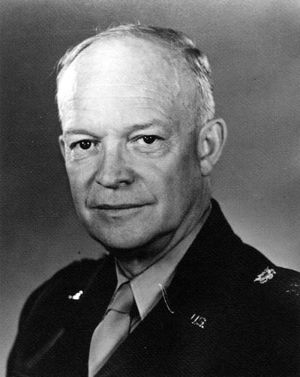Dwight D. Eisenhower
General of the Army Dwight David Eisenhower ("Ike") (1890-1969) was an American soldier who fought in World War I, was a top commander in World War II, and served as the 34th president of the United States (1953-1961). During the war he first commanded Ally troops in North Africa in 1942, then became the Supreme Commander of the forces that invaded Normandy on D-Day, June 6, 1944.
Eisenhower's political affiliations were unknown for many years and he was courted by both the Democratic and Republican parties. Eventually he declared for the Republicans and was elected to the presidency as a moderate Republican. His presidency was marked by the armistice in the Korean War, the construction of Interstate Highway System, the Eisenhower Doctrine of the Cold War, the passage of the first civil rights bill in 82 years, and moderate domestic policies known as "dynamic conservatism". Although a renowned military figure, at the end of his presidency, Eisenhower issued a famous warning to the American public about the dangers of the military-industrial complex.
1952 Presidential campaign
Part of Eisenhower's campaign was the employment of a very catchy slogan--"I Like Ike"--that was produced in part by Roy Disney and the Citizens for Eisenhower-Nixon. This slogan was illustrated in a short animation[1], as well as on pin-on buttons.
References
- Albertson, Dean. Eisenhower as President (1963) online edition
- Alexander, Charles C. Holding the Line: The Eisenhower Era, 1952-1961 (1975) online edition
- Ambrose, Stephen E. Eisenhower: Soldier, General of the Army, President-Elect; Eisenhower: The President; one volume edition is Eisenhower: Soldier and President (2003), standard scholarly biography
- Beschloss, Michael R. MAYDAY: Eisenhower, Kruschev, and the U-2 Affair
- Bischof, Gunter (Ed.) and Ambrose, Stephen E. (Eds.) Eisenhower: A Centenary Assessment
- Bowie, Robert R. and Immerman, Richard H. Waging Peace: How Eisenhower Shaped an Enduring Cold War Strategy
- Damms, Richard V. The Eisenhower Presidency, 1953-1961 (2002)
- D’Este, Carlo. Eisenhower, A Soldier’s Life (2002), 848 pages, strongest on WW2
- Divine, Robert A. Eisenhower and the Cold War (1981) online edition
- Eisenhower, David. Eisenhower At War 1943/45 solid biography by his grandson
- Galambos, Louis (Ed.), Eisenhower’s Legacy: The General, The President, The Public Servant
- Greenstein, by Fred I. The Hidden-Hand Presidency: Eisenhower as Leader (1991)
- Harris, Seymour E. The Economics of the Political Parties, with Special Attention to Presidents Eisenhower and Kennedy (1962) online edition
- Krieg, Joann P. Dwight D. Eisenhower, Soldier, President, Statesman (1987) online edition
- Olson, James S. Historical Dictionary of the 1950s (2000) online edition
- Pach, Chester J. and Elmo Richardson. Presidency of Dwight D. Eisenhower (1991)
- Parmet, Herbert S. Eisenhower and the American Crusades (1972) online edition
- Pogue; Forrest C. The Supreme Command (1996) online edition
- Sixsmith, E. K.G. Eisenhower, His Life and Campaigns (1973) online edition
- Wagner, Steven. Eisenhower Republicanism: Pursuing the Middle Way. (2006). 179 pp. isbn 978-0-87580-362-3.)
Primary Sources
- Eisenhower, Dwight D. Crusade In Europe (1948), war memoir
- Eisenhower, Dwight D. White House Years- Mandate for Change, 1953-1956
- Eisenhower, Dwight D. White House years- Waging Peace, 1956-1961
- Eisenhower, Dwight D. Mandate for Change, 1953-1956 (1963) important memoir
- Eisenhower Papers 21 volume scholarly edition; complete for 1940-61.
- Farewell speech, 1960
Memoirs by aides
- Benson, Ezra Taft. Cross Fire: The Eight Years With Eisenhower by the Secretary of Agriculture
- Butcher, Harry C. My Three Years With Eisenhower by wartime aide
Notes
- ↑ Internet archive, Eisenhower Campaign Spots (1952). Retrieved on 2007-09-11.
